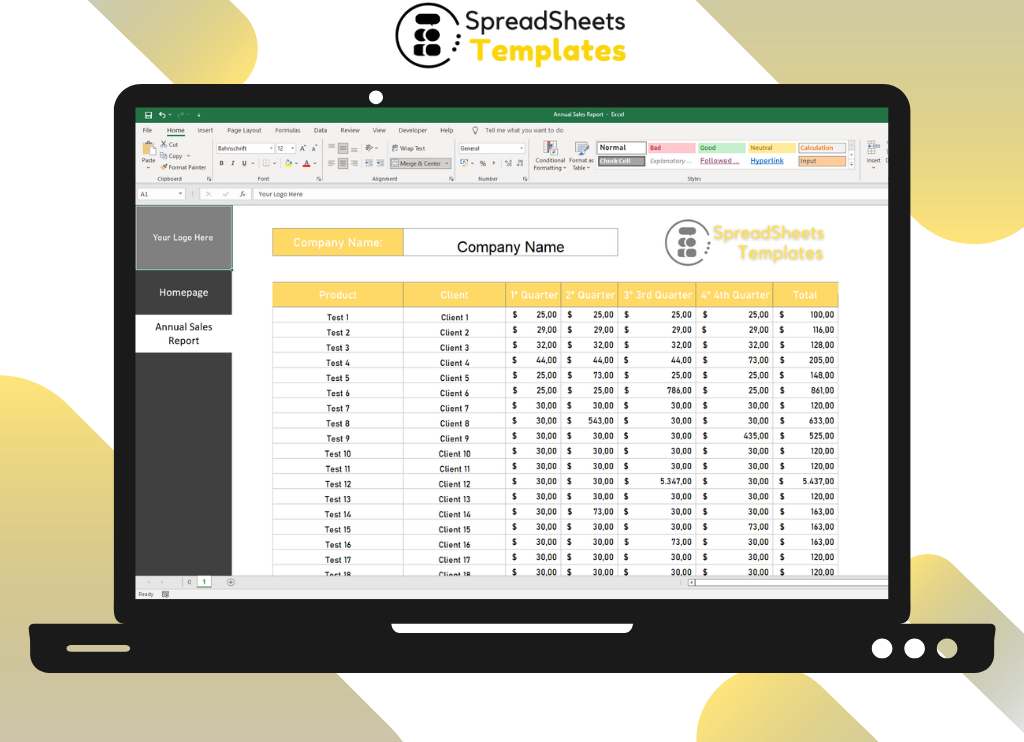Annual Sales Report Worksheet Leave a comment
A Comprehensive Guide to Boost Your Business Performance
Introduction
In today’s highly competitive business landscape, keeping track of your sales performance is essential for sustainable growth and success. The annual sales report worksheet serves as a powerful tool to analyze and evaluate your business’s sales figures, identify trends, and make informed decisions for the future. In this comprehensive guide, we will explore the importance of the annual sales report worksheet, its key components, and how to utilize it effectively to enhance your business performance.
Table of Contents
- Understanding the Significance of the Annual Sales Report Worksheet
- Key Components of an Annual Sales Report Worksheet
- Benefits of Regularly Reviewing Your Annual Sales Report
- How to Create an Effective Annual Sales Report Worksheet
- Analyzing Sales Data: Important Metrics and KPIs
- Leveraging the Annual Sales Report Worksheet for Growth Strategies
- Incorporating Technology and Automation in Sales Reporting
- Best Practices for Interpreting and Presenting Sales Data
- Common Challenges in Sales Reporting and How to Overcome Them
- Frequently Asked Questions (FAQs)
1. Understanding the Significance of the Annual Sales Report Worksheet
The annual sales report worksheet provides valuable insights into your business’s sales performance over a specific period, typically a year. It allows you to track revenue, analyze sales trends, identify areas of improvement, and make informed decisions based on data-driven insights. By having a comprehensive understanding of your sales performance, you can develop strategies to increase revenue, optimize resources, and drive overall business growth.
2. Key Components of an Annual Sales Report Worksheet
To create a comprehensive annual sales report worksheet, it is important to include the following key components:
Sales Overview
Provide a summary of your sales performance, including total revenue, number of units sold, and average sales value. This section gives an overall snapshot of your sales figures.
Sales by Product/Service
Break down your sales by product or service categories. This helps identify top-performing products/services and areas that require improvement or marketing focus.
Sales by Region/Market
Analyze sales performance based on different regions or markets. This information helps you identify geographical areas with high sales potential or those that require additional attention.
Sales by Customer Segments
Segment your customer base and analyze sales performance within each segment. This allows you to identify your most valuable customers and tailor your marketing efforts accordingly.
Sales by Sales Representative
Evaluate individual sales representative performance by tracking their sales figures. This enables you to identify top performers, provide targeted training, and optimize resource allocation.
Sales Growth Analysis
Compare sales figures from the current year with previous years to analyze growth rates. This analysis helps you understand the trajectory of your business and set realistic growth targets.
3. Benefits of Regularly Reviewing Your Annual Sales Report
Regularly reviewing your annual sales report worksheet offers several benefits for your business:
- Identify Growth Opportunities: By analyzing sales data, you can identify potential growth opportunities, whether it’s expanding into new markets, launching new products, or targeting untapped customer segments.
- Optimize Sales Strategies: The insights gained from sales reports allow you to refine your sales strategies, adjust pricing, improve customer service, and align marketing efforts to achieve better results.
- Track Performance: The annual sales report worksheet enables you to track your sales performance over time and identify trends. This helps you assess the effectiveness of your sales initiatives and make data-driven decisions.
- Enhance Decision-Making: Armed with accurate sales data, you can make informed decisions regarding inventory management, resource allocation, sales projections, and budget planning.
4. How to Create an Effective Annual Sales Report Worksheet
Creating an effective annual sales report worksheet involves the following steps:
- Determine Your Reporting Period: Decide on the time frame for your annual sales report. It is typically based on a fiscal year, but it can also align with the calendar year or any other specific period that makes sense for your business.
- Gather Sales Data: Collect data from various sources, such as your sales CRM, accounting software, or manual sales records. Ensure the accuracy and completeness of the data before proceeding.
- Choose Relevant Metrics: Select the key metrics that align with your business goals and objectives. Common metrics include revenue, units sold, average order value, customer acquisition cost, and customer lifetime value.
- Organize Data in a Spreadsheet: Use spreadsheet software like Microsoft Excel or Google Sheets to organize your sales data. Create separate tabs or sheets for different components of the report, such as sales overview, product/service breakdown, regional analysis, etc.
- Visualize Data: Utilize charts, graphs, and tables to present your sales data visually. Visual representations make it easier for stakeholders to understand and interpret the information.
- Provide Analysis and Insights: Accompany your sales data with detailed analysis and insights. Explain the trends, patterns, and factors influencing the sales performance. This will add context and value to the report.
- Review and Refine: Before finalizing your annual sales report worksheet, review it thoroughly for accuracy, clarity, and consistency. Make any necessary revisions and refinements to ensure it effectively communicates your sales performance.
5. Analyzing Sales Data: Important Metrics and KPIs
To gain valuable insights from your annual sales report worksheet, it is essential to focus on key metrics and KPIs (Key Performance Indicators). Some important metrics to consider include:
- Revenue: The total income generated from sales.
- Units Sold: The number of products or services sold within the reporting period.
- Average Sales Value: The average monetary value of each sale.
- Customer Acquisition Cost: The cost associated with acquiring new customers.
- Customer Lifetime Value: The predicted revenue generated from a customer throughout their relationship with your business.
- Sales Conversion Rate: The percentage of leads or prospects that convert into paying customers.
- Sales Growth Rate: The rate at which your sales revenue is growing year over year.
6. Leveraging the Annual Sales Report Worksheet for Growth Strategies
The annual sales report worksheet serves as a valuable tool for developing growth strategies. Here are some ways you can leverage it:
- Identify High-Performing Products/Services: Analyze the sales breakdown by product or service category to identify top performers. Focus on these products/services for further growth and expansion.
- Discover New Market Opportunities: Use the regional sales analysis to identify markets with high growth potential. Develop targeted marketing campaigns and sales strategies to penetrate these markets effectively.
- Optimize Sales Channels: Evaluate the performance of different sales channels (e.g., online, retail, direct sales) and allocate resources accordingly. This helps maximize sales opportunities and streamline operations.
- Segment and Personalize Marketing: Utilize customer segment data to personalize marketing messages and offers. Tailoring your marketing efforts to specific customer segments can yield higher conversion rates and customer satisfaction.
7. Incorporating Technology and Automation in Sales Reporting
In today’s digital age, incorporating technology and automation in sales reporting can streamline the process and enhance accuracy. Here are some ways to leverage technology:
- CRM Integration: Integrate your sales report worksheet with a Customer Relationship Management (CRM) system to automate data collection and analysis. This reduces manual effort and ensures real-time data accuracy.
- Data Visualization Tools: Utilize data visualization tools like Tableau, Power BI, or Google Data Studio to create visually appealing and interactive sales dashboards. These tools make it easier to interpret complex sales data.
- Automated Reporting Software: Invest in sales reporting software that automates the generation of sales reports. These tools can pull data from multiple sources, generate reports with customizable templates, and schedule automatic report delivery.
- Mobile Accessibility: Choose sales reporting tools or software that offer mobile accessibility. This allows sales representatives to input data on the go, ensuring real-time and accurate sales reporting.
8. Best Practices for Interpreting and Presenting Sales Data
To effectively interpret and present sales data in your annual sales report worksheet, consider the following best practices:
- Provide Context: Explain the factors that influenced sales performance, such as market conditions, industry trends, or specific marketing campaigns. This adds context to the data and helps stakeholders understand the underlying factors driving sales.
- Compare Against Benchmarks: Benchmark your sales performance against industry averages, competitors, or previous years’ performance. This comparison provides insights into your relative performance and highlights areas that need improvement.
- Use Visuals: Utilize charts, graphs, and tables to visually represent your sales data. Visuals are easier to comprehend and make the information more engaging for readers.
- Highlight Key Findings: Summarize the most important findings and insights from your sales data. This helps readers focus on the key takeaways and facilitates quick understanding.
- Provide Actionable Recommendations: Based on the sales data analysis, offer actionable recommendations for improving sales performance. These recommendations should be practical, measurable, and aligned with your business objectives.
9. Common Challenges in Sales Reporting and How to Overcome Them
While creating and analyzing the annual sales report worksheet, you may encounter certain challenges. Here are some common challenges and tips to overcome them:
- Data Accuracy: Ensure the accuracy of your sales data by implementing data validation techniques, double-checking entries, and verifying the integrity of your data sources.
- Data Integration: If you gather sales data from multiple sources, ensure proper integration and synchronization to avoid data discrepancies. Utilize data integration tools or consult with IT professionals if needed.
- Data Overload: Avoid overwhelming your readers with too much data. Focus on key metrics and provide clear and concise analysis to highlight the most important insights.
- Data Security: Protect your sales data by implementing appropriate security measures. This includes encryption, restricted access, and regular backups to prevent data breaches or loss.
- Interpretation Bias: Be mindful of interpretation bias when analyzing sales data. Ensure your analysis remains objective and consider seeking external input or involving multiple stakeholders for a well-rounded perspective.
- Lack of Actionable Insights: Strive to provide actionable insights based on your sales data analysis. Avoid presenting data without clear recommendations or suggestions for improvement.
Frequently Asked Questions (FAQs)
1. What is an annual sales report worksheet?
An annual sales report worksheet is a comprehensive document that summarizes a business’s sales performance over a specific period, typically a year. It includes key metrics, such as revenue, units sold, average sales value, and provides insights for decision-making and growth strategies.
2. How can an annual sales report worksheet benefit my business?
Regularly reviewing an annual sales report worksheet helps identify growth opportunities, optimize sales strategies, track performance, and enhance decision-making. It provides valuable insights into your business’s sales performance and aids in setting realistic goals for future growth.
3. How do I create an effective annual sales report worksheet?
To create an effective annual sales report worksheet, gather accurate sales data, choose relevant metrics, organize the data in a spreadsheet, visualize the data using charts and tables, provide analysis and insights, and review and refine the report before finalizing it.
4. Can technology and automation help with sales reporting?
Yes, technology and automation can streamline sales reporting processes. Integration with CRM systems, data visualization tools, automated reporting software, and mobile accessibility can enhance data accuracy, analysis, and report generation.
5. What are some best practices for interpreting and presenting sales data?
Best practices for interpreting and presenting sales data include providing context, comparing against benchmarks, using visuals, highlighting key findings, and providing actionable recommendations based on the analysis.
6. What are the common challenges in sales reporting?
Common challenges in sales reporting include data accuracy, data integration from multiple sources, data overload, data security, interpretation bias, and ensuring the report provides actionable insights. These challenges can be overcome through careful data management, validation, and analysis techniques.
Conclusion
The annual sales report worksheet is an indispensable tool for understanding and improving your business’s sales performance. By diligently tracking and analyzing your sales data, you gain valuable insights that can drive growth, optimize strategies, and make informed decisions. Remember to regularly review and update your annual sales report worksheet to adapt to evolving market conditions and business goals. With a well-crafted and insightful annual sales report worksheet, you can unlock the potential for enhanced business performance and sustained success.


